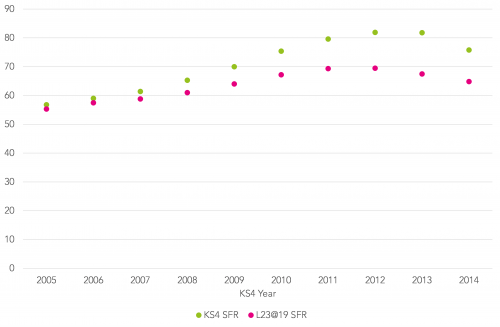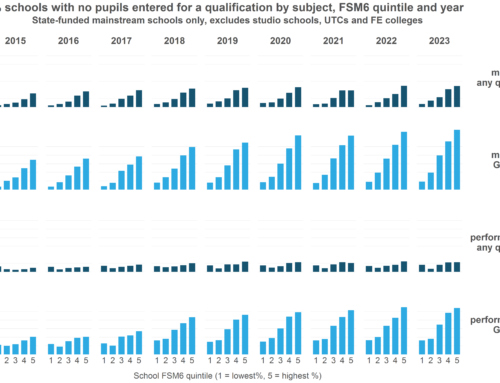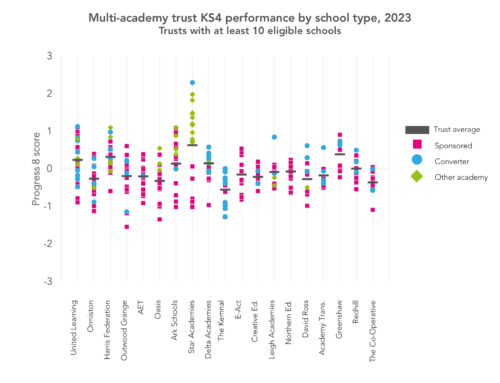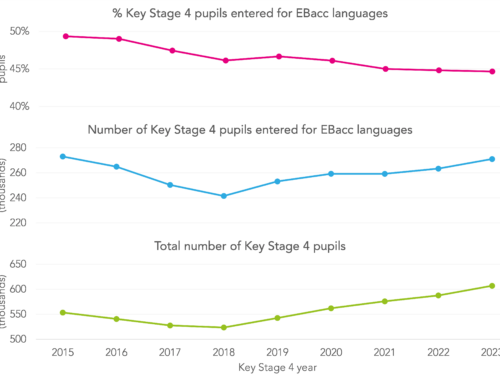Aficionados of DfE Statistical First Releases (SFRs) were shocked to their very core a couple of weeks ago with the revelation that the percentage of 19-year-olds qualified to Level 2 had fallen for the first time since records began. In the real world this equates to young people achieving five or more GCSEs at grades A*-C or equivalent. (Unlike the previous headline measure of school performance this doesn’t have to include an English or maths qualification at grade A*-C.)
As the chart below shows, records began for the cohort which turned 19 in 2004. Since then, the blue dots show year-on-year increases until 2015, and then a slight drop – from 87.5% to 86.7% in 2016.
The pink dots show the percentage of the cohort who were qualified to Level 2 by the time they were 16. Here we also see consistent increases for all cohorts until the 2015 cohort. The vast majority of this cohort would have reached the end of Key Stage 4 in 2012. For subsequent cohorts we see consistent decreases in percentages qualified to Level 2 by 16. These four cohorts would have reached the end of Key Stage 4 between 2013 and 2016.
Percentage of young people qualified to Level 2 by the year they turn 19

So on the surface it appears that the dip in Level 2 attainment by 19 is largely to do with a dip in Level 2 attainment by 16. If that’s the case then we might have to brace ourselves for further falls in Level 2 attainment by 19 in the years ahead.
Is the chart telling us the full story?
There’s more going on than this chart shows, however.
This new release of data on Level 2 and 3 qualifications by age 19 tells us that 67.5% of the cohort which turned 19 in 2016 had achieved Level 2 by age 16, three years earlier.
But other figures – given in the Key Stage 4 SFR – show that 81.8% of pupils achieved five or more A*-C grades (or equivalent) in 2013. There will be slight differences in cohort coverage, of course, but this is a fairly sizeable difference.
In the next chart, we compare the percentages of 16-year-olds qualified to Level 2 according to both the Level 2 and 3 by age 19 SFR, and the Key Stage 4 SFR.
It’s worth emphasising that point: while one of the sets of data is taken from the Level 2 and 3 by age 19 SFR, both of the series are looking at the number of young people achieving Level 2 by the same age – age 16.
To make life a bit easier, the horizontal axis shows the year the cohort (for the most part) reached the end of Key Stage 4 (note that this differs from the chart above).
Percentage of young people qualified to Level 2 at age 16 by KS4 year and SFR

For the cohort which reached the end of KS4 in 2005, the two SFRs present very similar figures for the percentage qualified to Level 2. But then the figures begin to diverge.
The reason for this lies in the coverage of qualifications counted in both SFRs. Up until 2013, the KS4 SFR counted all pre-16 approved qualifications. However, the Level 2 and 3 by age 19 SFR only counts a subset of qualifications (see page 4 of the technical guidance [PDF]). In practice this means GCSEs, AS-Levels, IGCSEs and ‘large’ vocational qualifications (minimum of 325 guided learning hours).
This means that a whole raft of smaller ‘equivalent’ qualifications are not counted in the Level 2 and 3 by age 19 SFR even though they are counted in the KS4 SFR.
These include courses that were incredibly popular in the years up to 2013, such as the OCR National First Award in ICT. Consequently, the current Level 2 and 3 by age 19 SFR is missing a sizeable chunk of young people who have achieved Level 2 as a result of achieving small ‘equivalent’ qualifications among their portfolio.
More change to come
Further changes to the Key Stage 4 accountability regime from 2014 onwards will also have an effect on the Level 2 and 3 by age 19 statistics in future. The cohort which completed Key Stage 4 in 2014 were the first affected by the changes introduced following the Wolf Review of 2011. These included:
- A reduced set of qualifications included in performance tables;
- Counting a pupil’s first entry in a qualification rather than their best qualification;
- Changes to the sizes of qualifications so that no single qualification could be considered to be larger than a GCSE.
This led to wholesale changes to the types (and numbers) of qualifications for which schools entered pupils, as we wrote in this blogpost two years ago. These will have knock-on effects on the Level 2 and 3 by age 19 statistics in the years to come until the Key Stage 4 accountability regime reaches some sort of steady state.
In any event, basing the Level 2 and 3 by age 19 calculations on all approved qualifications would be a step forward.
Want to stay up-to-date with the latest research from Education Datalab? Sign up to our mailing list to get notifications about new blogposts, or to receive our half-termly newsletter.





Leave A Comment